Here’s my guide to visiting the magnificent Basilica of Santa Maria Maggiore in Rome. This guide gives you an overview of the history of the church. It also tells you everything you need to see inside.
Rising up on Esquiline Hill, this jewel of a church is one of Rome’s most important. It’s the oldest standing Christian church in Rome and one of the most beautiful churches in Italy. The basilica is a must see site and attraction in Rome.
The church’s soaring columns, gleaming marble, sparkling mosaics, and magnificent statues will astound you. Santa Maria Maggiore is just as spectacular as St. Peter’s Basilica, but without the crowds.
The basilica is a UNESCO-listed site in Rome’s Monti area, which dates to the 5th century. It’s one of four papal basilicas in Rome, under the direct authority of the pope.
The other three are Saint Peter’s Basilica, Saint John in Lateran, and Saint Paul Outside the Walls. On a visit, you’re in Vatican territory without being in Vatican City.
READ: Complete Guide To St. Peter’s Basilica
The basilica retains its original shape (with some embellishments). The basilica’s claim to fame is a perfectly preserved Byzantine interior. 5th and 13th century mosaics decorate both sides of the nave and the apse.
The church is free to visit, but you may want to book a guided tour to see it all.
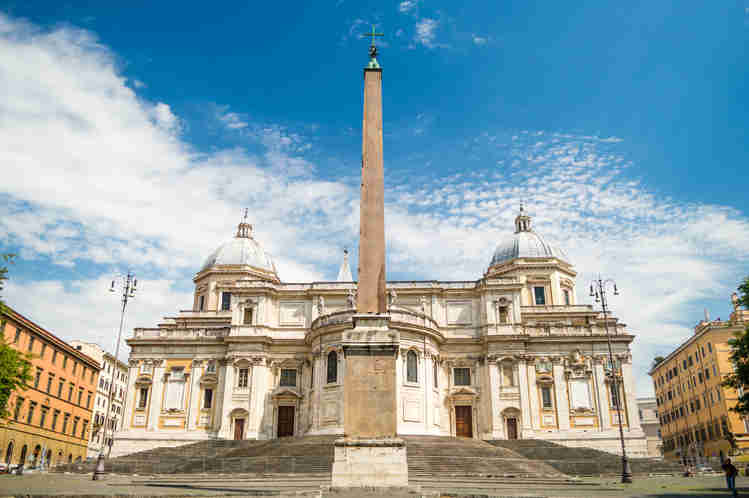
Piazza dell’ Esquilino and the rear facade
History of Santa Maria Maggiore
The Basilica of Santa Maria Maggiore was built at the top of Cispius, the highest part of the Esquiline Hill, which is the highest of the seven hills of Rome. The medieval bell tower of the basilica is also the tallest in Rome, at 250 feet.
Legend holds that the basilica was founded in the year 356 after a miraculous event: snowfall in the middle of August. According to the tale, the Virgin Mary came to Pope Liberius and another Roman patrician Johannus in a dream. She told them to build a basilica on the place they found snow the following morning.
The area covered in unexpected summer snow was used as an indication for the church’s perimeter. Building began immediately, funded by Johannus, who was heirless.
The famous snowfall is recreated and celebrated annually in a digitized show in the Sistine Chapel of the basilica.
Liberius’ church was burned down. Between 432-40, Pope Sixtus III built a new church, dedicating it to Mary.
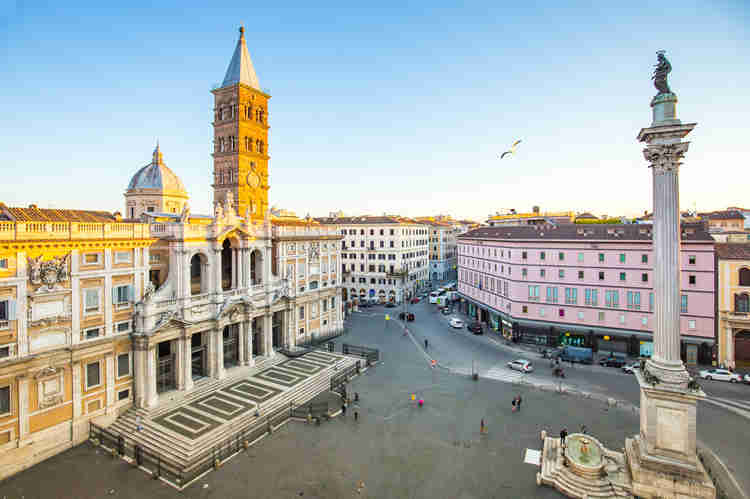
Piazza Santa Maria Maggiore
Guide To Santa Maria Maggiore: What To See
The basilica is an architectural hybrid. It dates back to 438 A.D. But the church represents every major time period between the 5th and 13th centuries.
The church has a 14th century Romanesque style campanile, a Renaissance coffered ceiling, an 18th century Baroque facade, a largely Baroque interior, and a series of glorious 5th and 13th century mosaics.
Here are 15 things you can’t miss at Santa Maria Maggiore:
1. Two Facades
While the church interior is classical, the church’s loggia facade, on the Piazza Santa Maria Maggiore, is decidedly Baroque or even Rococo. It was created by Fernando Fuga in 1761.
The Loggia of Blessing on the second floor is topped with a sculptural group. At the center are Mary and Jesus. They’re flanked by popes.
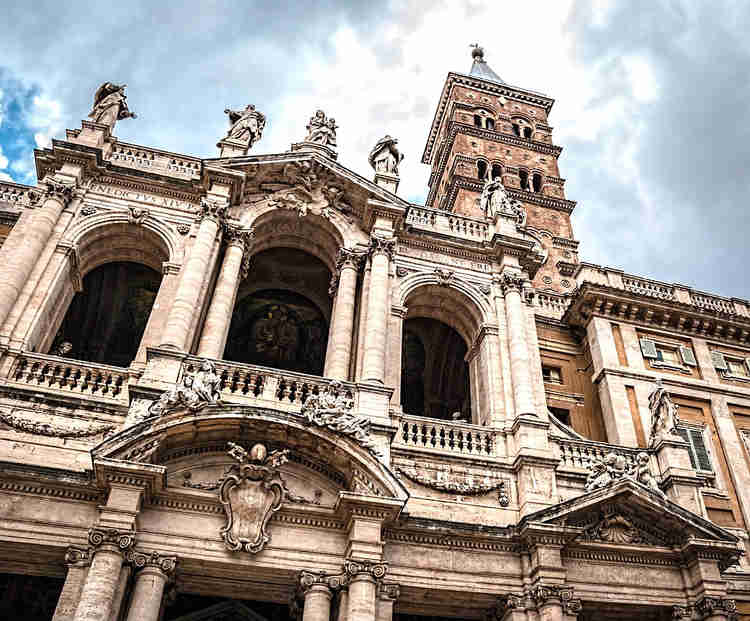
the Loggia of Blessing on the facade
The front facade has five portals or doors. The middle three doors access the nave. The central bronze door dates from 1949 and is by Lodovico Pogliaghi. On the far left is the Holy Door, which is only opened on Jubilee years.
The facade stands in front of an older facade, which is decorated with glimmering mosaics. They were created between 1305-25 by Filippo Rusuti. The top mosaic shows Jesus enthroned, his right hand in blessing.
The lower mosaics depict the founding of the church, including the visions of the snow. They were sponsored by the powerful Colonna family.
READ: Guide To Palazzo Colonna
In front of the facade is the last intact column from Emperor Maxentius’s basilica on the Roman Forum. It was erected in 1613 by the architect Carlo Maderno and is topped with a statue of Mary and Jesus.
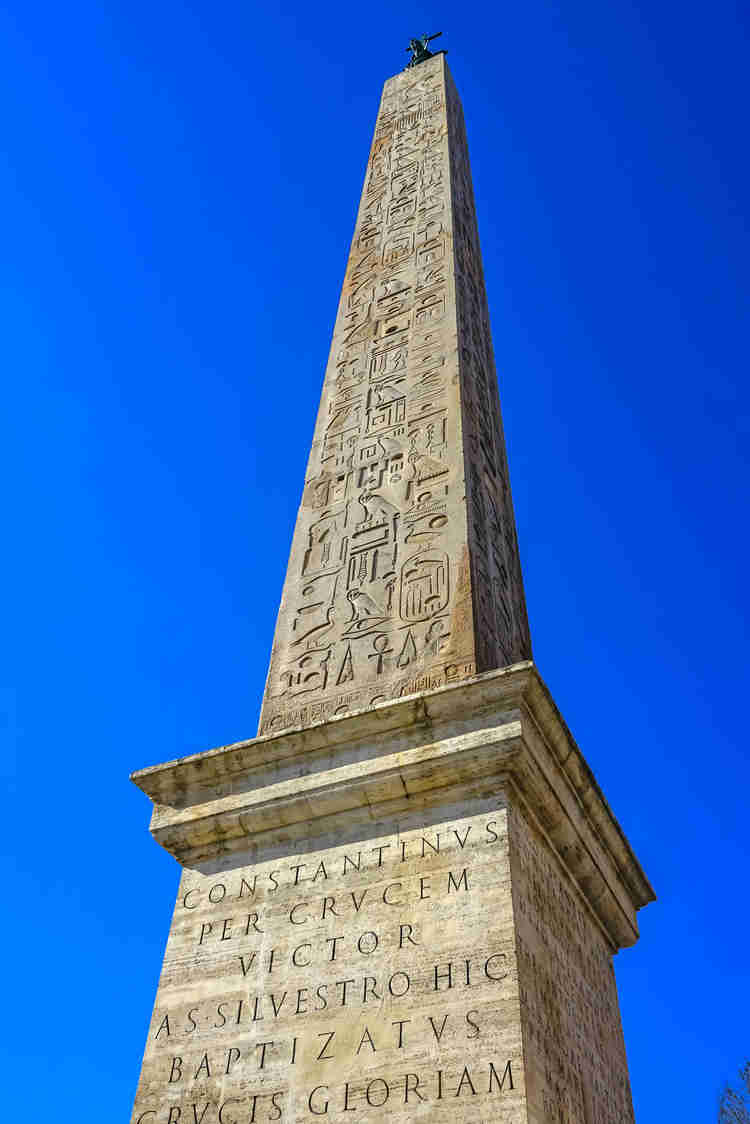
Egyptian obelisk on the rear facade
The rear facade is topped with twin domes. You can see the rounded exterior wall of the apse. It’s decorated with stone plaques, ornate balustrades, and various sculptures of angels and saints.
The obelisk at the rear facade came from the Mausoleum of Augustus, installed there by Pope Sixtus V.
2. Campanile
The campanile rises behind the front facade on the Piazza Santa Maria Maggiore. It was erected in 1377 by the French Pope Gregory XI.
It’s Rome’s tallest bell tower at 250 feet. It commemorated the return of the papacy from Avignon to Rome after 70 years of the Catholic schism. You see, the popes haven’t always lived in Rome. You can climb the bell tower for some awesome views.
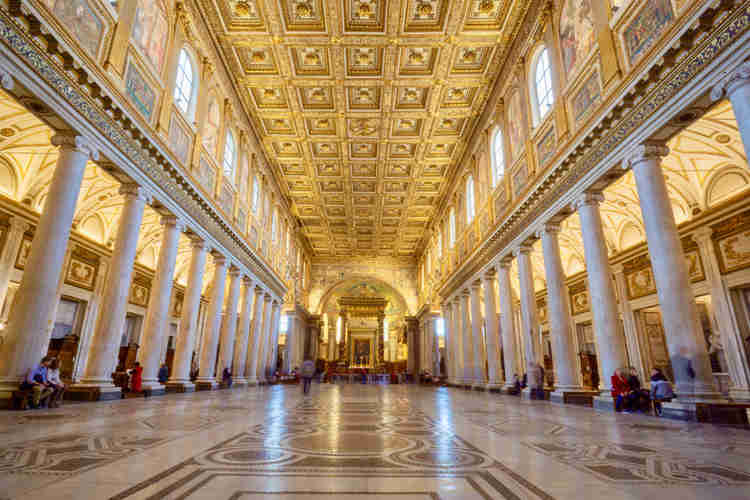
nave of the basilica
3. Nave
You walk in and are confronted with an enormous and gorgeous space. The airy church has a simple basilica plan consisting of a wide central nave flanked by two side aisles. The nave is almost 250 feet long.
The width and height of the nave are in a precise 1:1 proportion. The aisles are separated by massive colonnades.
The interior is reminiscent of an ancient Roman forum. Instead of the altar in the apse, one can almost imagine a Roman emperor sitting on a throne while citizens gathered around.
The perfectly proportioned nave is anchored by 36 ancient Ionic columns made of white Parian marble. The columns are monolithic. Arched windows above and between each column let in light.
In the 18th century, the facade architect Fugo took the ancient columns and made them all a uniform size. He gave them new bases and Ionic captitals.
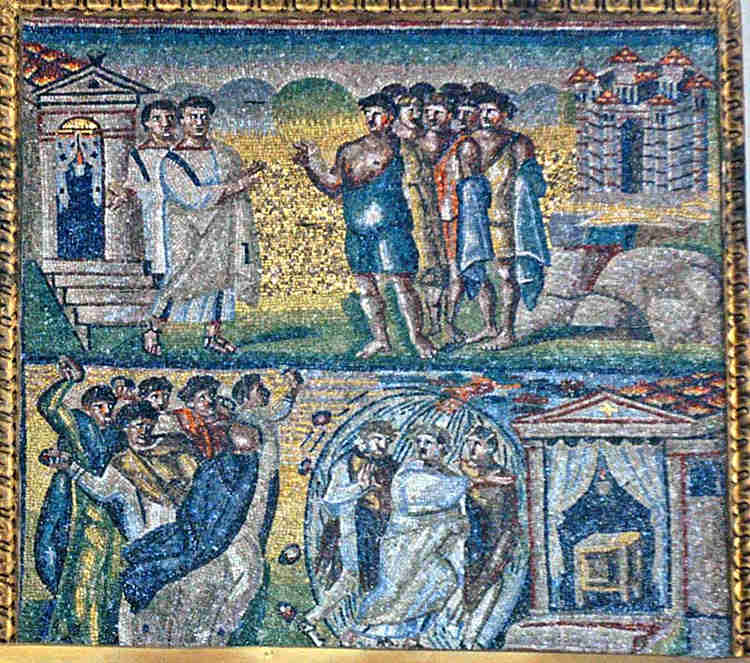
mosaics in the nave
4. Nave Mosaics
The basilica’s oldest element, and greatest treasures, are the 5th century mosaics lining the nave. They’re some of the world’s best. The beautiful mosaics date back to the 400s when Pope Sixtus III built the church.
READ: Guide To the Byzantine Mosaics of Ravenna
The Byzantine style mosaics are set in a series of square gold frames above the colonnade. They are arranged chronologically from the front of the church to the rear.
There are 19 on the right and 14 on the left. They tell Old Testament stories — the stories of Abraham, Isaac and Jacob, and Moses (rather odd in a church dedicated to Mary).
Above the mosaics are a series of murals. The murals depict some of the earliest known images of Mary.
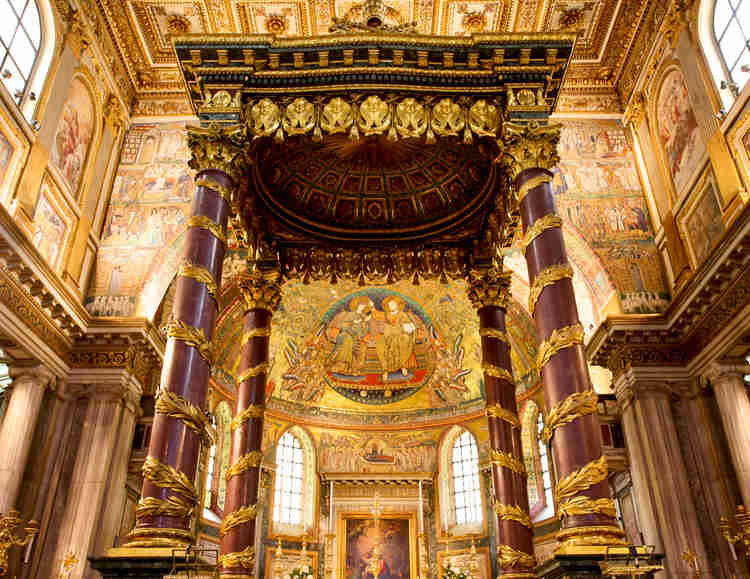
the Fugo-designed baldachin above the high altar
5. Baldachin and High Altar
The Baldachin will immediately remind you of Bernini’s Baldachin at St. Peter’s Basilica. Designed by Fugo, it has a similar canopy and columns with spirals of golden palm leaves. The ceiling has a dove, representing the Holy Spirit.
Under the baldachin is the high altar where the pope gives mass. The high altar consists of a red porphyry urn. Behind the baldachin is a large painting of the nativity in the Patrizi Chapel.
6. Renaissance Ceiling
The basilica ceiling was originally wooden. But now it shows off a stunning coffered and gilded ceiling. Commissioned in 1450 by Pope Callixtus X, it was sculpted by Giuliano da Sangallo in 1450.
In the center of each coffer is a central flower bordered by flowers and vines set against a white background. There’s a Borgia coat of arms in the center, since the Borgia popes were the patrons.
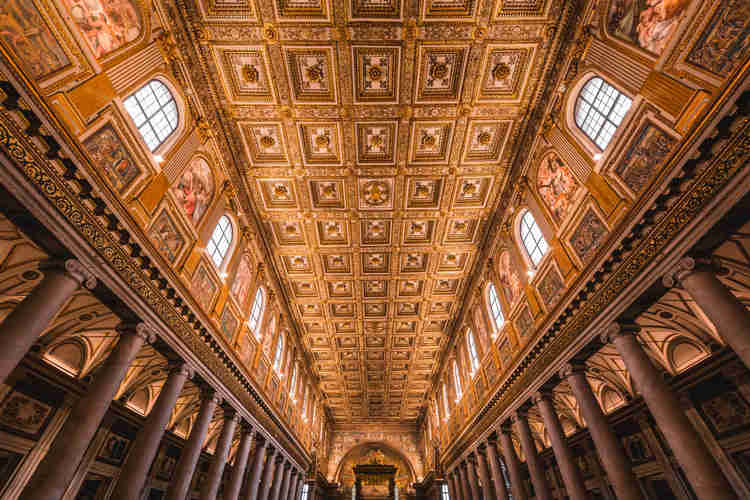
stunning gold coffered ceiling
The ceiling is covered in gold, allegedly brought back by Columbus. It was said to be a gift from Spain’s King Ferdinand and Queen Isabella to Pope Alexander VI.
7. Cosmatesque Floors
The church’s beautiful Cosmati pavement, with inlaid marble chips in geometric patterns, was added in 1288. The floors have beautiful violet and red colors, which contrast nicely with the gold ceiling. One design has four intertwined circles and two intertwined triangles.
There are several inlaid tombs in the pavement, including that of the famous Johannus who funded the original church.
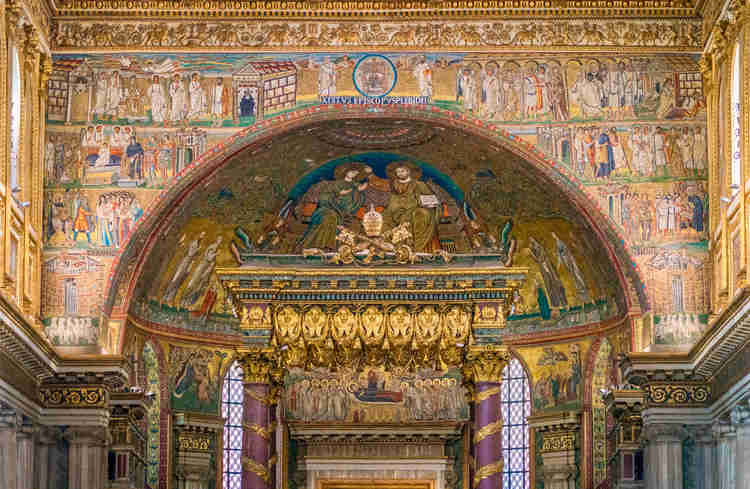
the apse, with mosaics and the upper part of the baldachin
8. Apse Mosaics
In the triumphal arch of the apse, you’ll find 5th century mosaics depicting Old Testament scenes. Peter and Paul flank the Mercy Seat, with beasties from Noah’s arc above them.
The central image in the apse, the Life of the Virgin, is by Jacopo Torriti. The mosaics are incredible, created in 1295-1305. The most famous scene, in the middle, shows Mary’s coronation.
Jesus crowns Mary as they float in a bubble across an antique arabesque. They’re supported by a throng of angels. Above them, is a roundel representing heaven. Saints and popes are to the right and left.
The mosaic is important because you can see the first hints of the Renaissance. There’s a bit more physicality, perspective, and depth to the figures. They’re not purely Byzantine anymore. Torriti was influenced by Giotto, the most famous painter of the early Renaissance.
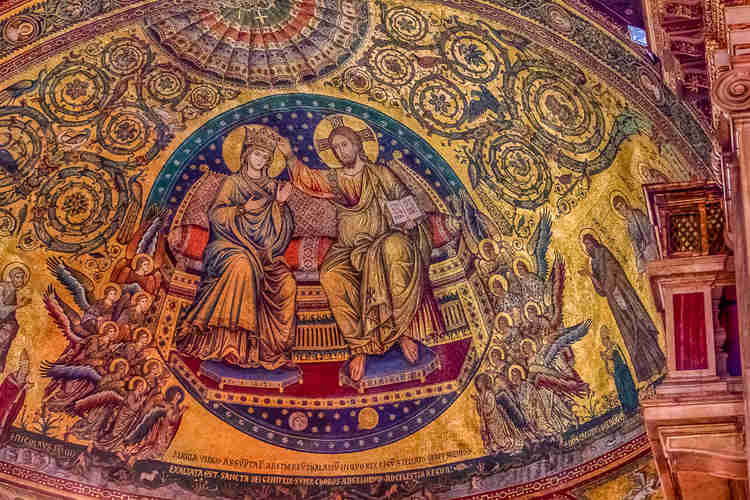
detail of the apse mosaic
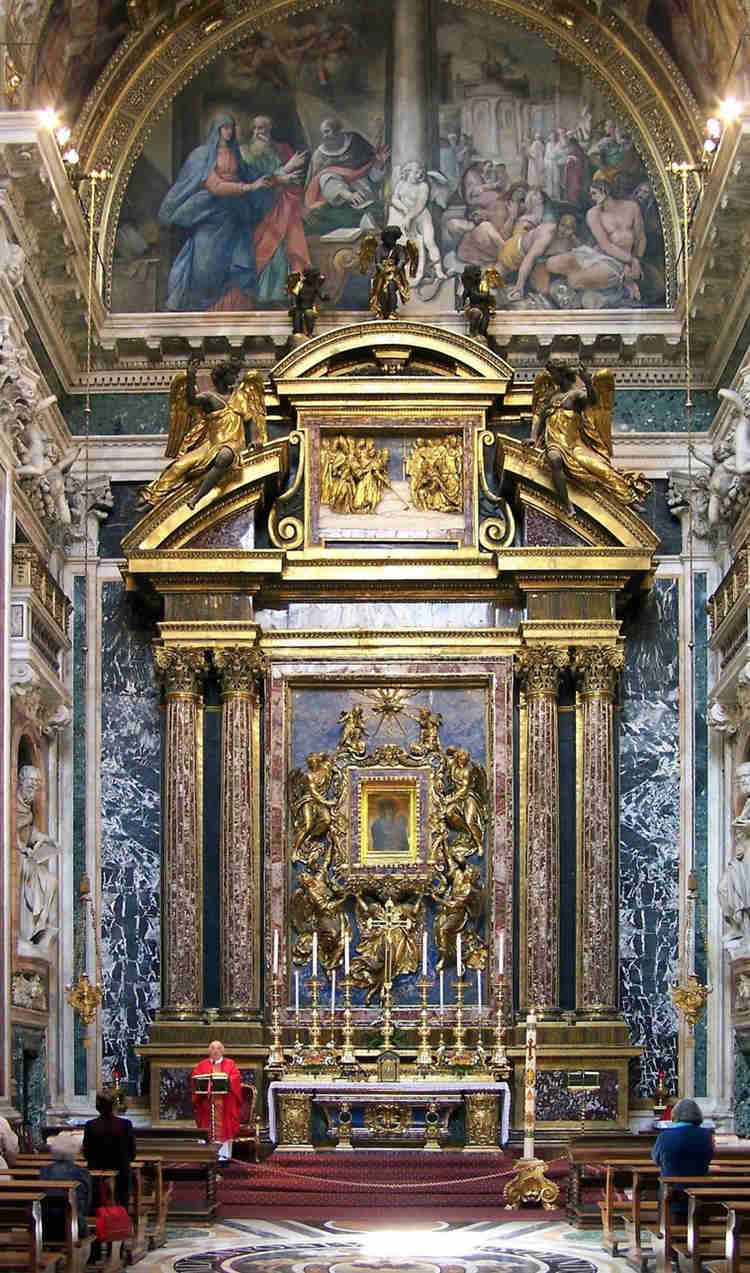
the Borghese or Pauline Chapel
9. Borghese or Pauline Chapel
The over-the-top Borghese Chapel is also called the Pauline Chapel. It’s in the left transept and is all spectacle. The chapel was built in 1611 by Flamino Ponzio for Camillo Borghese.
READ: Guide To Rome’s Borghese Gallery
The large chapel is temple size and lavishly decorated with fluted Corinthian marble columns and gold leaf. There are large frescos in the lunette and the dome above by Guido Reni.
The chapel has an incredibly elaborate altar tabernacle that’s home to a tiny prize: an inset Byzantine style painting of the Virgin and Child. By legend, it’s attributed to Saint Luke, who was believed to be the first Christian painter.
Luke purportedly copied an icon that was in a town in Israel. But this is false. Historians date the painting to either the 8-9th centuries or the 12-13th centuries. Still, it could be well over a thousand years old.
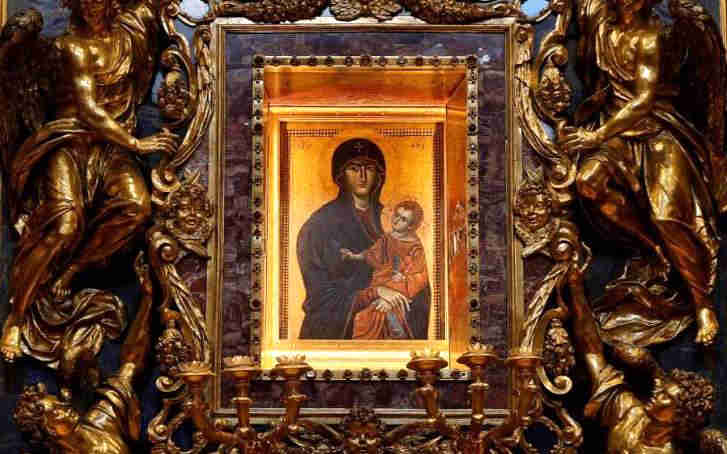
In the painting, Mary looks outward and baby Jesus looks up at her. Both are relatively flat with elongated features. Typical of the medieval style, they’re set against a gold background
The medieval painting is nicknamed the Savior of the People of Rome. Legend holds that it was carried by Pope Gregory throughout Rome to drive out the plague in 593. But it’s also a symbol of the savior Mary holds in her arms.
The icon was restored in 2017-18 by a workshop of the Vatican Museums. Gold angels carry the image, announcing its importance. Columns serve as theater curtains, revealing the sacred object, a typical Baroque flourish.
The entablature in the pediment above the painting shows the miracle of the snow in bronze relief by Stefano Maderno. You can see Pope Liberius outlining the church in the snow.
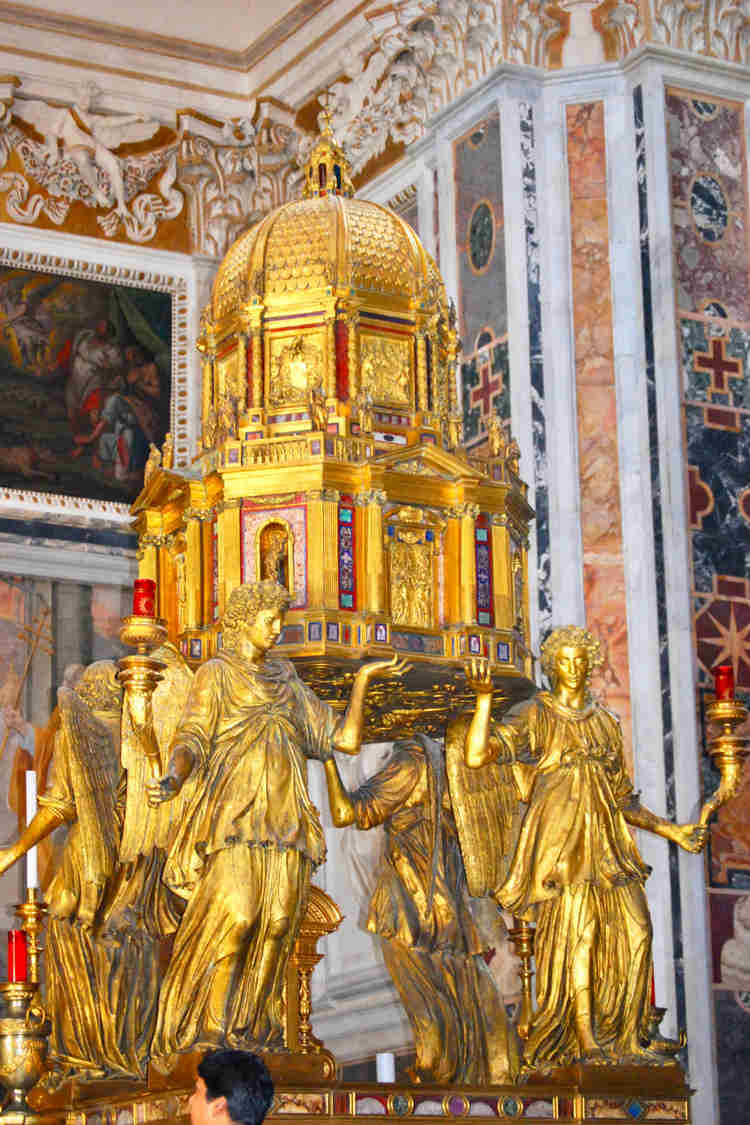
tabernacle in the Sistine Chapel
10. Sistine Chapel
The Sistine, or Holy Sacrament, Chapel is in the right transept. It’s the other Sistine Chapel in Rome, though not nearly as magnificent as the one in the Vatican Museums with Michelangelo frescos.
READ: Guide To Michelangelo’s Frescos in the Sistine Chapel
The chapel was built in the 16th century by Domenico Fontana for Pope Sixtus V, whose tomb you’ll find there. The chapel frescoes celebrate Mary and were executed by a team of artists led by Cesare Guerra and Giovanni Nebbia.
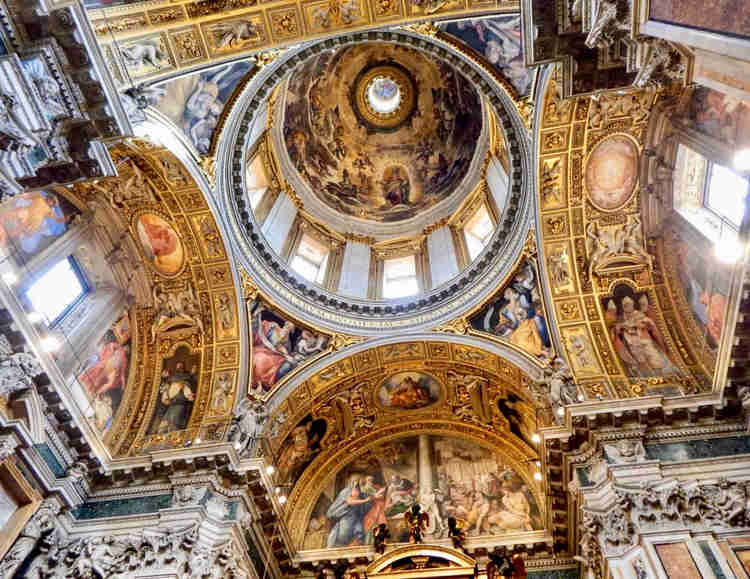
dome of the Sistine Chapel
The gold altar in the center (shown above) is quite lovely, set on a Comatesque marblebase. Four gold leafed life size angels created by Sebastiano Torregiani hold up a model of the actual chapel. The model is richly decorated with angels and prophets with bas relief on the doors.
The chapel contains a statue depicting St. Cajetan Holding the Holy Child by Bernini. And there’s a famed nativity scene (or at least some crib figures) by Florentine artist and architect Arnolfo di Cambio, of Florence Cathedral fame in the crypt.
This is where, each year on August 5th, white rose petals are showered from its ceiling honoring the miracle of the snow.
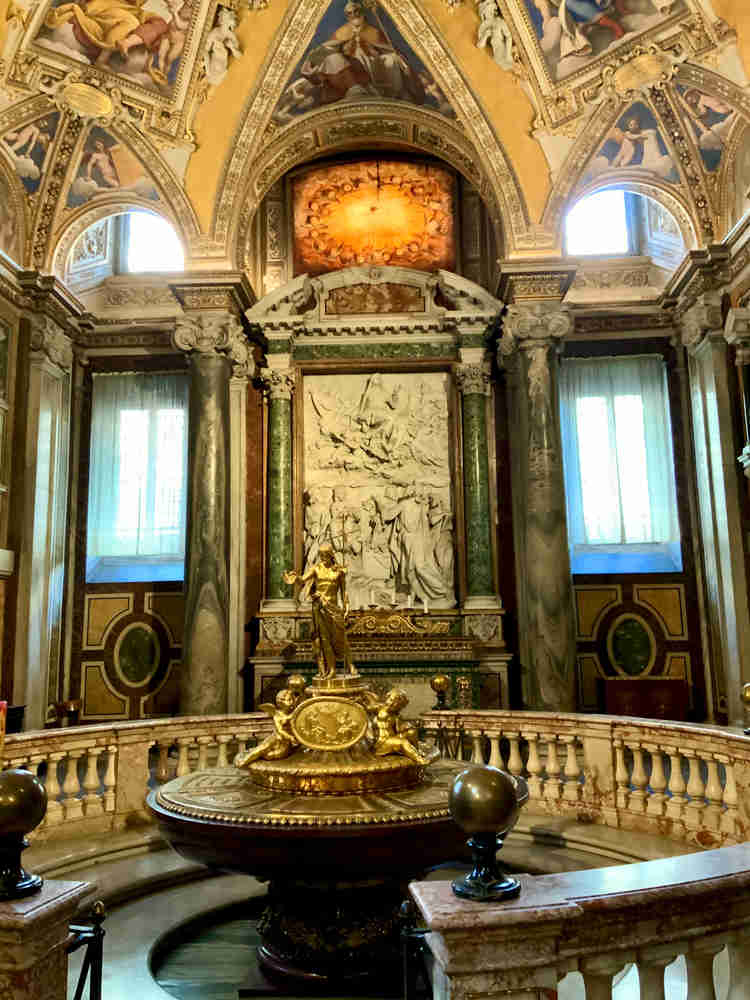
the Baptistery
11. Baptistery
The Baptistery is off the right nave near the front of the basilica. The baptistry has two bays, an antechamber, and the baptismal chamber proper.
There’s a marble bas relief of the Assumption of Mary over the altar. It was carved by the Pietro Bernini, father of Lorenzo Bernini. Above that is a glowing image of the Eye of Providence.
READ: Guide To the Bernini Trail in Rome
The baptismal font is attributed to Giuseppe Valdier. It has a red porphyry base topped by a golden sculpture. The Baptistery has marble walls, frescoed ceilings, and gold stucco work.
12. Statues
There are plenty of statues worth a look in the basilica, including: (1) Queen of Peace (shown above); (2) the Tomb of Nicholas IX; (3) the Tomb of Clement IX; (4) the Tomb of Cardinal Rodrigo Consalvi; and (5) the Monument to Agostino Favoriti.
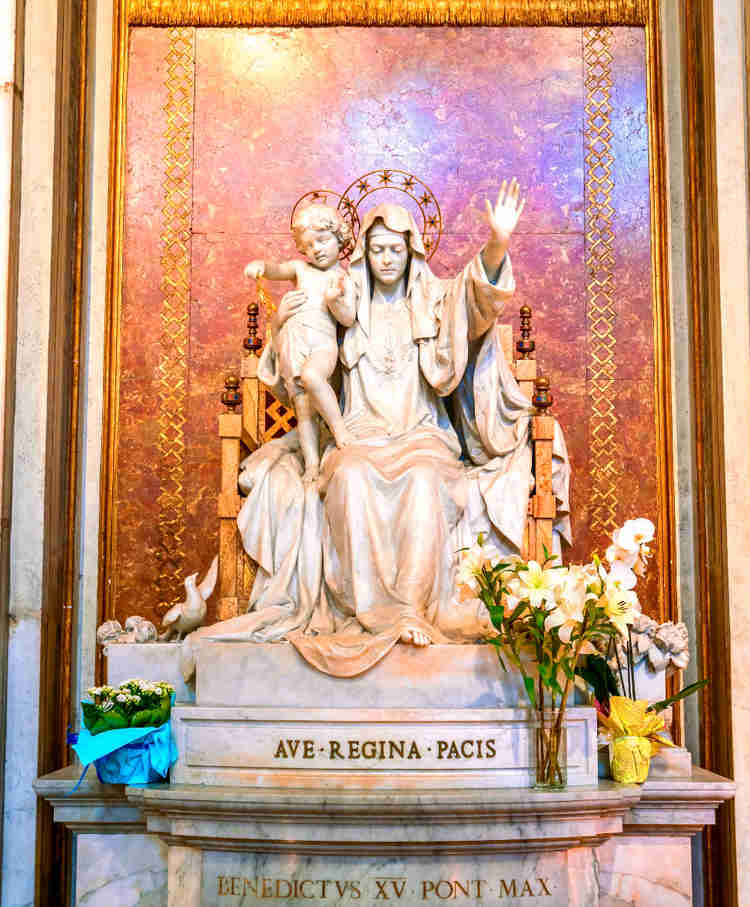
20th century statue of the Queen of Peace, commissioned after WWII
13. Relics
Santa Maria Maggiore has loads of relic — a piece of Jesus’ Holy Crib, shards from the Holy Manger, and a piece of the True Cross.
The crypt of the nativity, down a flight of stairs in front of the main altar, is called the Confessio. This is where you’ll find the precious manger reliquary, called the Santa Culla.
The relic consists of five pieces of the crib used on the flight from Egypt. The church displays the relics as evidence that Mary was the mother of Jesus.
The reliquary is displayed in a six foot tall urn adorned with gold, silver, and rock crystal, with baby Jesus plopped on top. A marble statue of Pope Pius IX kneels before the reliquary. You’ll also find the tomb of Pope Pius V in the crypt.
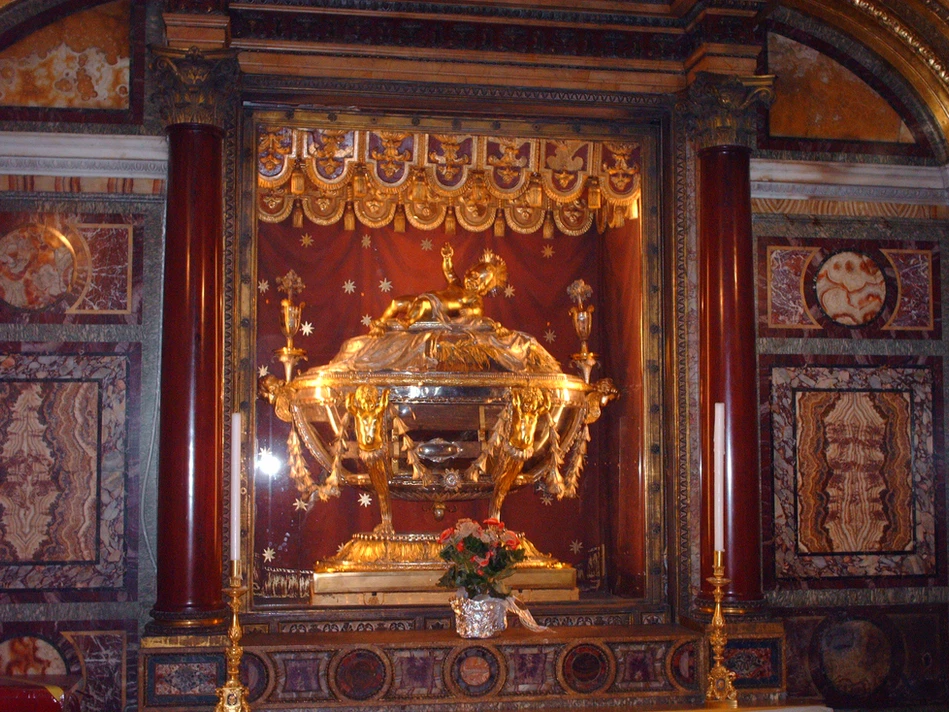
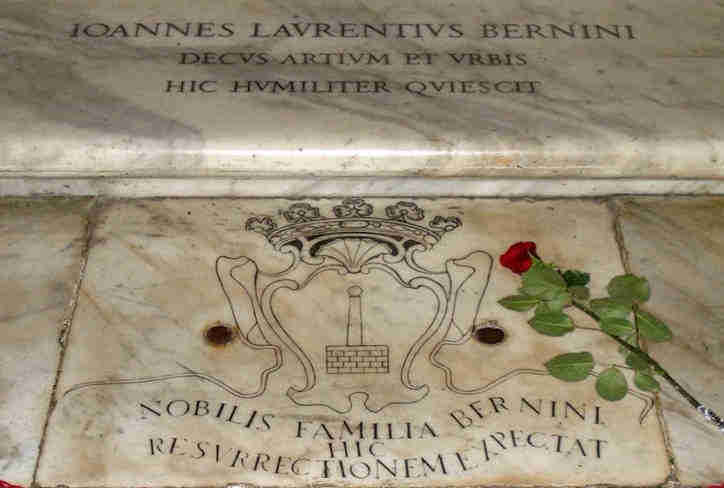
tomb of Bernini, the Baroque’s most famous sculptor
14. Bernini Tomb and Staircase
Bernini fans can pay homage to the greatest sculptor of the Baroque in the basilica. His tomb is to the right of the high altar on the step. The inscription says “Gian Lorenzo Bernini, the glory of the arts and of the city, here rests humbly.”
If you take a guided tour, you’ll get to see a secret spiral staircase designed by Bernini himself. It’s in a residential apartment attached to the basilica. The staircase is an architectural curiosity because there’s no central supporting rail.
15. Loggia delle Benedizioni
This upper loggia can only be visited on a 30 minute guided tours. You can book a tour at the entrance. This is where you can inspect the 13th century mosaics on the front facade, which were created by Filippo Rusuti.
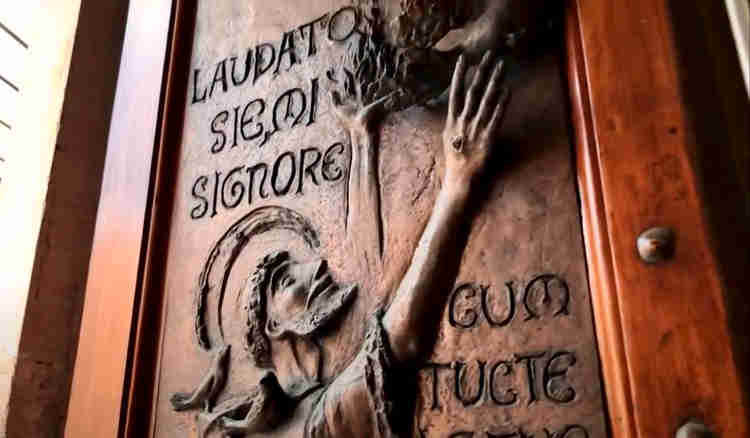
door with a relief of Saint Francis of Assisi
Practical Information Santa Maria Maggiore:
Address: Piazza de Santa Maria Maggiore
Hours: Open Mon to Sat from 7:00 am to 7:00 pm. Sunday from 9:00 am to 12:00 pm.
Entry fee: Free. Access to the Loggia of Blessings is via the museum for € 5.
Getting There: The Termini metro stop is 5 minutes away. If you’ve just visited the Colosseum, the church is less than 10 minutes away.
Pro tips: Dress modestly. Dress code is enforced by a guard at the door.
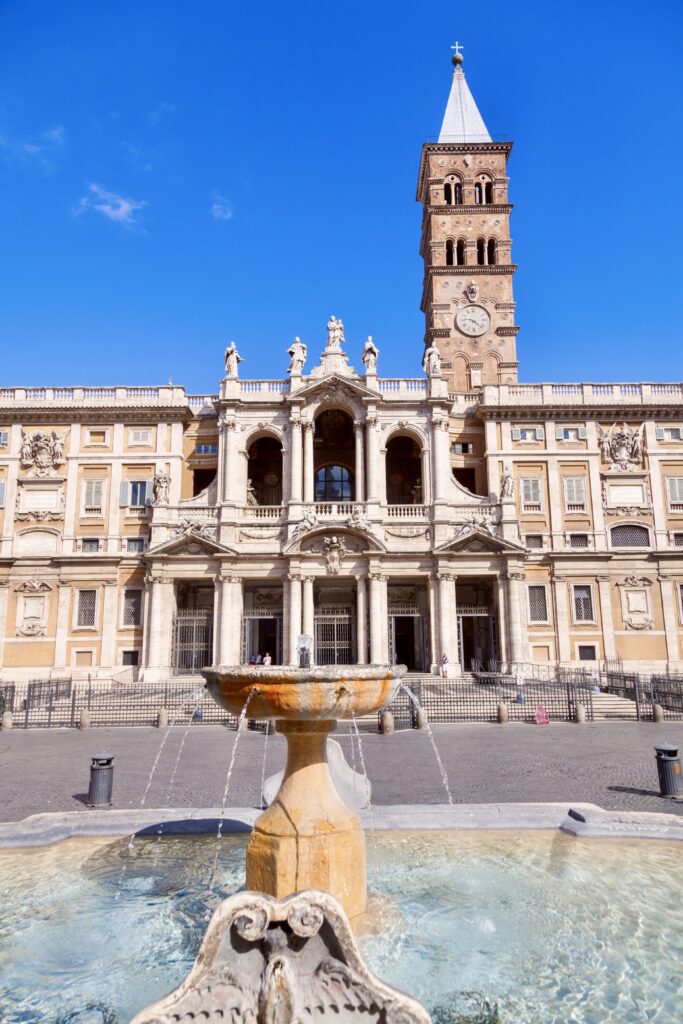
I hope you’ve enjoyed my guide to visiting the Basilica of Santa Maria Maggiore. You may enjoy these other Rome travel guides and resources:
- 8 Ways To Spend 1 days in Rome
- 3 Days in Rome Itinerary
- 5 Days In Rome Itinerary
- Hidden Gems in Rome
- Rome’s Palace Museums
- Bernini Guide to Rome
- Caravaggio Guide to Rome
- Guide to the Best Museums in Rome
- Guide To the Doria Pamphilj Gallery
- Must See Archaeological Sites & Ruins
- 50 Facts About Rome
If you’d like to visit Rome’s Basilica of Santa Maria Maggiore, pin it for later.

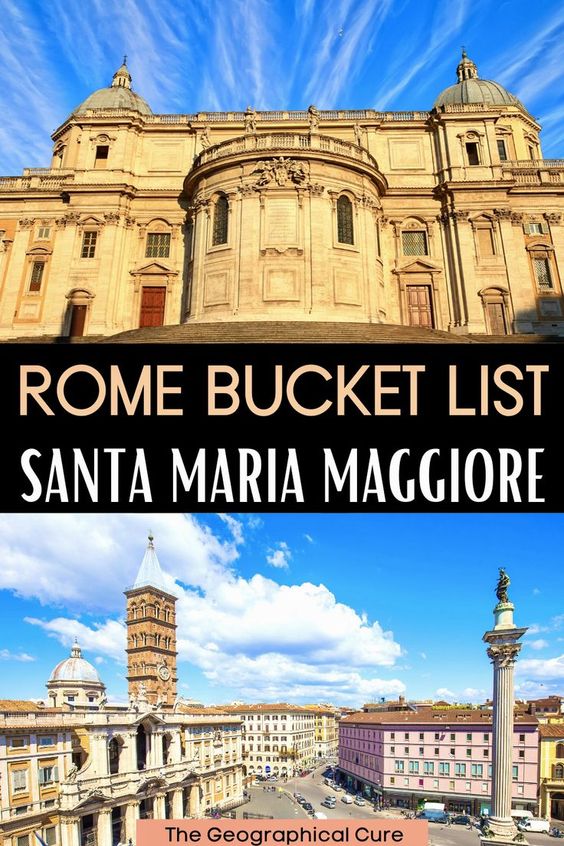
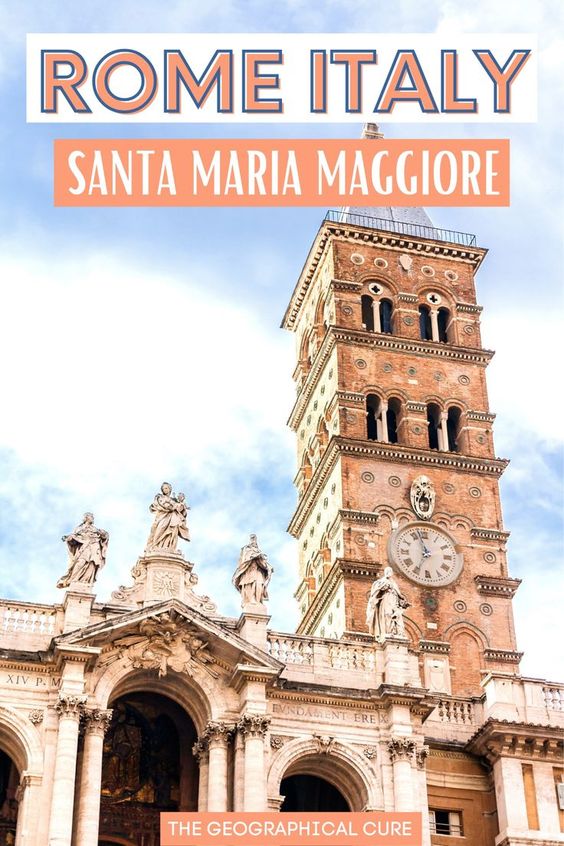
Yours is a very thoughtful guide through this historic marvel!!
Thank you.
You’re welcome!
Informative and helpful.
It was a spectacular church to visit
Yes it was! Thanks Paul.
Your commentary adds insight to the art, architecture and history of this amazing basilica in Rome. You are right, the magnificence of St. Peter’s without the crush of crowds.
So glad you enjoyed it Deb!